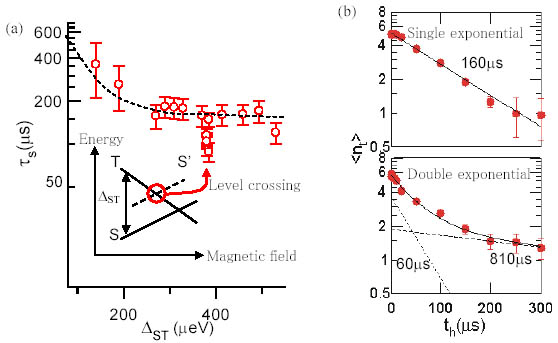Satoshi Sasaki, Toshimasa Fujisawa, Toshiaki Hayashi and Yoshiro Hirayama
Physical Science Laboratory
Coulomb interaction between electrons produces spin singlet and triplet states in a semiconductor quantum dot hosting an even number of electrons. We have measured the spin relaxation time from a triplet excited state to a singlet ground state by applying fast pulse signals to the gate electrode (electrical pump-and-probe), which reveals a selection rule for the spin-orbit interaction.
Figure 1(a) shows the spin relaxation time, τs, as a function of the singlet (S)- triplet (T) energy difference, ΔST, when the spin relaxation occurs via spin-orbit interaction followed by
phonon emission. For ΔST = 300 µeV, the number of tunneling electrons, nt, decays exponentially as a function of the wait time, th, after an electron
is injected to the triplet state, as shown in the upper panel of Fig.1(b).
The spin relaxation time is determined to be τs =160 µs for this case. When ΔST is changed to 400 µeV by adjusting magnetic field, the triplet state
crosses another singlet state (S’) as schematically shown in the inset
to Fig.1(a). Then, the initial relaxation time drops to 60 µs and
the decay characteristics is given by a double exponential function as
shown in the lower panel of Fig.1(b). This double exponential behavior
reflects the selection rule for the spin-orbit interaction which allows
transition only from SZ (z component of the spin) = ±1 states out of the three triplet
sublevels. Then, the forbidden SZ = 0 triplet state involving opposite spins in two different orbitals can
be extracted by waiting long enough time, th. This scheme could be utilized to obtain spin entanglement state by separating
the two electrons composing the SZ = 0 state.
[1] S. Sasaki et al., Phys. Rev. Lett. 95 (2005) 056803.
 |
||||||
|
|
|||||